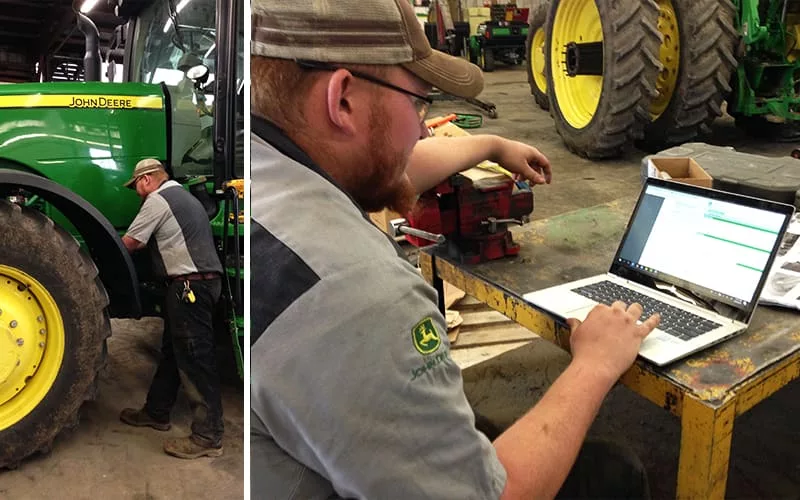Help wanted: younger, qualified workers.
Meeting the workforce development challenge at farm equipment dealerships requires effective outreach, close ties to high schools and technical colleges, and an understanding of what makes members of the latest generation of workers tick.
And that’s just a start.
It takes work and patience. But dealers hope they are beginning to make strides in recruiting and retaining younger employees, especially in the service department.
The Western Equipment Dealers Assn. wanted to get kids thinking about the importance of ag technicians at a young age by creating a coloring book sent to dealers to hand out at the parts counter. The Equipment Dealers Foundation, the charitable arm of the Equipment Dealers Assn., is holding its second Workforce Development Summit in October in Louisville, Ky., during the GIE+Expo.
At the dealership level, executives emphasize the need to be proactive in reaching out to teachers, counselors and students at high schools, technical colleges and four-year colleges.
“However dealerships accomplish it, the biggest thing is you have to get the word out to the right students,” says Jodi McGill, director of human resources at Plains Equipment Group in Lincoln, Neb.
Here’s a look at what Plains Equipment and some other dealers are doing to attract and retain younger workers:
The Skills Gap
A better understanding of workforce development challenges today requires a look back to the 1990s. “The parents of the kids we’re trying to attract right now were told ‘Look you need to get a four-year degree, you need to get off the farm, you need to stay away from the trades,’” recounts Wayne Brozek, vice president at 21st Century Equipment, a 20-store John Deere dealership group based in Scottsbluff, Neb.
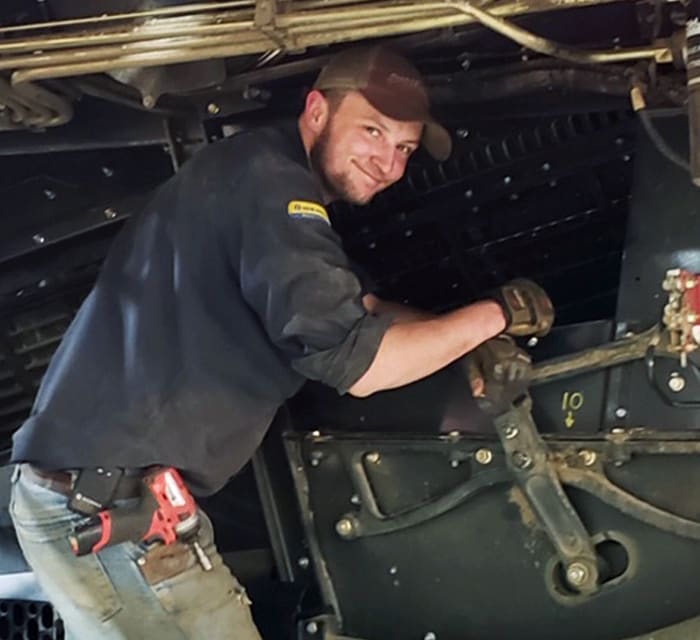
Plains Ag service technician Kyle Germann, a graduate of the North Dakota State College of Science Case IH program, has worked for Plains Ag for 5 years. The dealership has sponsored about a dozen students in the North Dakota State College program. Students in the sponsorship program can earn a $1,500 scholarship each year as well as a paid internship. (Photo courtesy of Plains Ag)
That, in turn, started to paint the picture of working in the trades as low-paying, low-skilled grunt work. “So generations coming up, myself included, were like ‘OK, I’m going to school. I’m going to stay away from the farm,’” Brozek says. “I’m going to get away from the trades, and I’ll get a (four-year) degree.”
High school teachers or counselors had offered similar guidance, placing emphasis on pursuing a bachelor’s degree. Richard Dugan, ag technician recruiter and trainer at KanEquip Inc., a 14-store New Holland dealer based in Wamego, Kan., had first-hand experience as a former teacher for 19 years.
Acquiring the skills needed to become a technician for the most part takes a two-year program.
“I think there is a misconception with the four-year degree that it’s where you make the big money. A technician can come out of school with a two-year degree and maybe be making $50,000-$60,000 a year…” — Deeann Grundstad, human resources director, Plains Ag
“I worked with students (who) would be ideal to go into two-year schools. However most schools looked at four-year colleges as a better opportunity for students,” Dugan says. “I always thought ‘Hey either way you’re going to college.’ It doesn’t matter if it’s two years or four years.’”
Employers in other trade fields, like electrical work and plumbing, have been equally challenged in finding qualified workers over the last 10-20 years. A generational gap widened in the workforce, especially in rural areas.
Shifting Trends
Brozek sees perceptions starting to change as educational trends shift. Graduating with a bachelor’s degree has become more of the norm, and in more fields, job seekers might need a graduate degree to gain an advantage. Meanwhile, higher education costs continue to climb.
This can make a two-year degree seem like a more attractive and economically viable option, especially with so many openings for service technician positions.
“I think there is a misconception with the four-year degree that it’s where you make the big money,” says Deeann Grundstad, human resources director at Plains Ag, a 15-store Case IH dealer based in Williston, N.D. “A technician can come out of school with a two-year degree and maybe be making $50,000-$60,000 a year.”
Brozek adds dealership owners realize that to attract technicians, “we’re going to have to pay them better than we paid the previous generations of techs.” But while higher salaries certainly can’t hurt, the recruitment and retention of a new generation of service technicians can come down to more than just pay.
Putting the ‘Tech’ in Technicians
Yes, working on that combine in the shop can be a dirty job. But as with nearly everything else in the industry, equipment is more reliant than ever on automated, high-tech systems. Acquiring the skills to fix equipment in the digital age can make a prospective employee more marketable in an industry desperately looking for qualified workers.
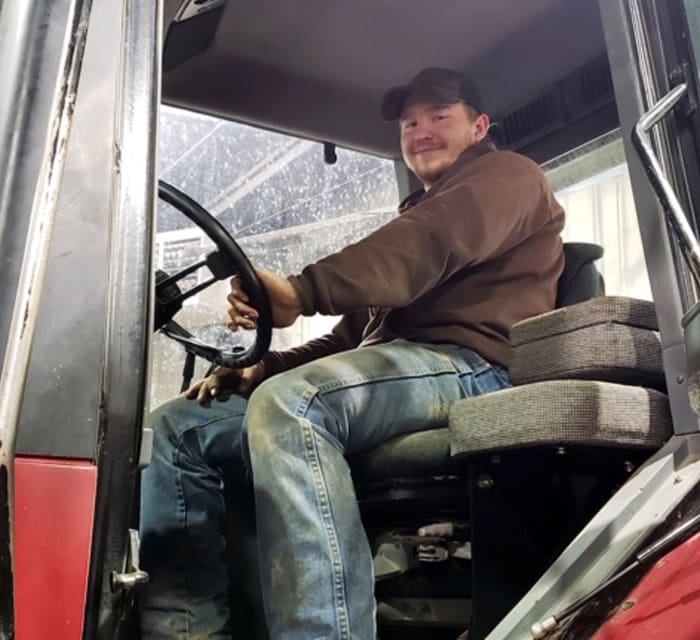
Plains Ag service technician Tanner Rohde, a graduate of the North Dakota State College of Science Case IH program, has been with Plains Ag for 6 years. In addition to Plains Ag’s sponsorship program at the college, the Case IH dealership also offers an educational reimbursement of up to $20,000 over 5 years. It is open to technicians who have graduated in the previous 2 years. (Photo courtesy of Plains Ag)
“Every piece of equipment we work on, you don’t start with a wrench and screwdriver and pair of pliers — you start with your computer,” Brozek says. “You hook your computer up to that piece of equipment first and foremost. Then you start diagnosing it.”
That computer work can be a draw to younger employees, because it’s not just all about getting greasy and dirty.
“That’s why we changed the name from ‘mechanics’ to ‘technicians.’ Whether auto technician or a heavy equipment technician, they truly have to have technical skills to work on these pieces of equipment,” Brozek says. “And in doing so, the trades are starting to look a whole lot better to young kids.”
Getting Into the Schools
Dealers can’t wait for applicants to come to them. Recruiting must be proactive, like attending career fairs and maintaining connections with counselors and teachers at high schools and colleges.

“I would like them at the shop a minimum of 90 days before they go to school. I want to make sure that student truly understands what he or she is getting themselves into. They look at the commitment they’re going to have and then decide — maybe this really isn’t the thing for me? I prefer that then to get into the class and 8 months later decide it really isn’t for them…” — Wayne Brozek, vice president, 21st Century Equipment
Like many other dealers, representatives of Stotz Equipment, a John Deere dealership with 25 locations in 8 states, visits high schools to help generate interest in service positions. If the school has an automotive program, a representative makes it a point to meet with the instructors and students to talk about their sponsorship program, says Chief Human Resources Officer Jared Nielsen.
Brozek says he tries to bring a current student or recent graduate from his dealership’s sponsorship program with him when he visits a high school, finding that a first-person account makes for a better connection with those in the classroom. “Instead of hearing from an old guy like me,” Brozek jokes. “They can’t relate to me.
“But if they can relate to somebody that’s in school right now that happens to be 18 or 19 years old and they’re saying ‘I love it,’ then the message really comes across strong,” he adds.
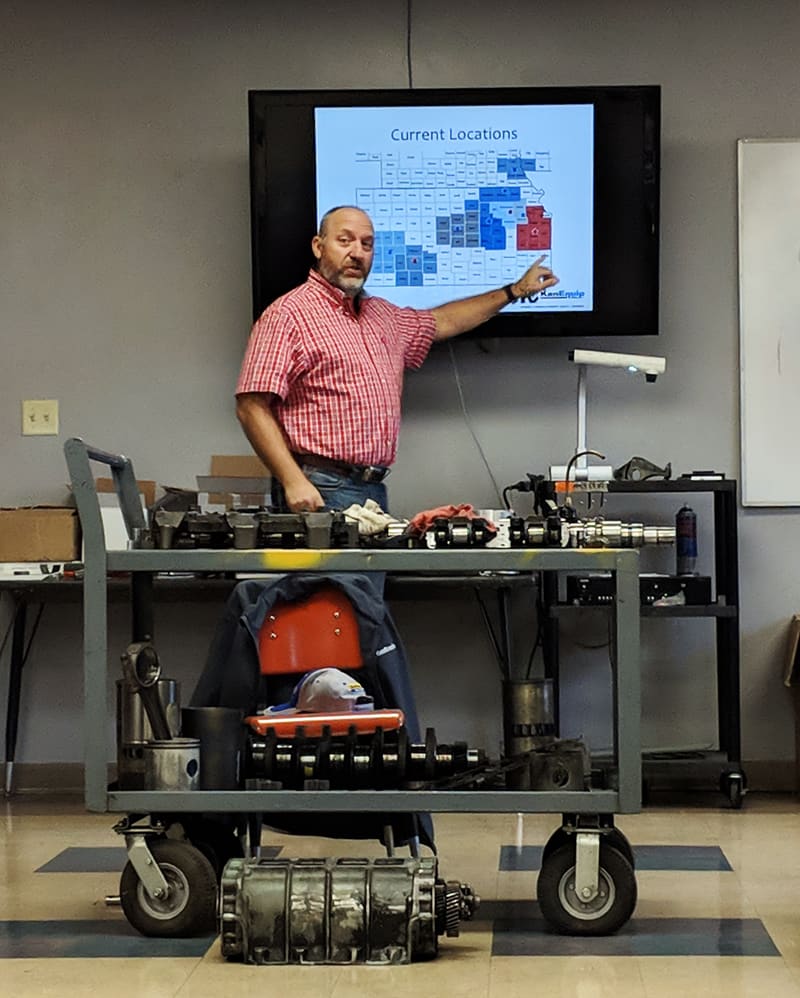
KanEquip's Richard Dugan gives a presentation at Northwest Technical College in Colby, Kan., about the company, careers as ag technicians and the KanEquip internship and sponsorship programs. Dugan is an ag technician recruiter and trainer for the New Holland dealership. (Photo courtesy of KanEquip)
Dugan’s background as a former teacher gives him a unique perspective now as a recruiter. At career fairs, he’s out in front of the presentation table meeting students. Not every dealership has a recruiting specialist on staff, so Dugan says he sometimes gets questions from managers for other dealerships attending the fairs. At times, those managers are juggling phone calls, too, to make a sale or handle another problem at a store, Dugan says, so the dedicated interaction of a recruiter can help.
Regardless of who is representing the dealership, the messages should be clear and forward-looking. Technology is just as important a tool in the service bay as a wrench.
“People that work on this computer, they’re not just somebody that can turn a wrench — they’re the doctors of equipment,” Dugan says.
Taking Different Approaches
Getting students to come into a dealership can help both the company and prospective employees get a head start in the search process.
Plains Equipment, a 15-store John Deere dealership based in Nebraska, started holding half-day events a few years ago at stores in which visiting high school students get a peek at what it might be like to work for the company. Instructors and counselors identify interested students ahead of time, in particular those who might want to become service technicians.
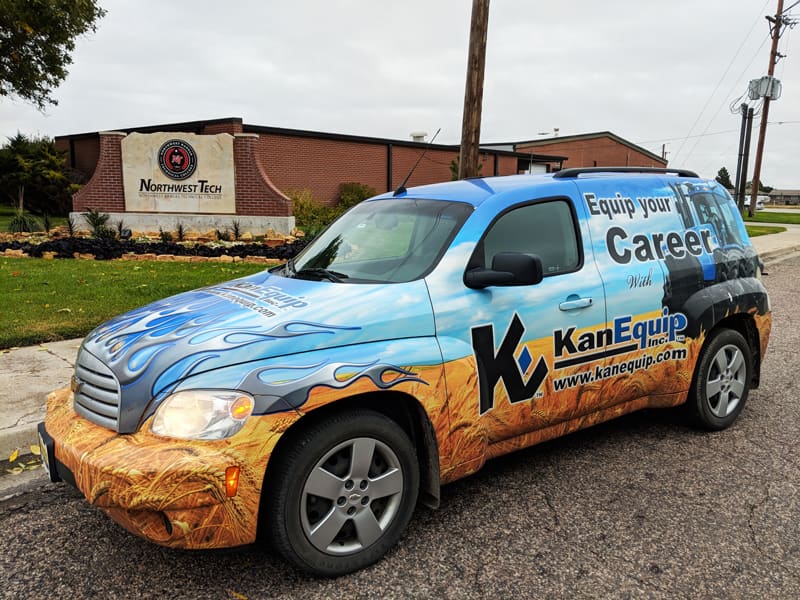
KanEquip's Richard Dugan, an ag technician recruiter and trainer, drives to recruiting events in a Chevrolet HHR that promotes the company. (Photo courtesy of KanEquip)
“From there, we do a lot of follow-up,” McGill says. The dealership collects demographic data and checks in periodically with an attendee on if he or she might be interested in part-time work. Those interested in being sponsored by the dealer in the John Deere Ag Tech program are invited to another half-day event in Milford, Neb., for more information.
McGill says they identify a few prospects each year from the in-store events and sponsor a handful of students each year in the ag tech program. “It’s a like a lot of things here. It’s a lot of work (and) your return on investment isn’t high … but you’ve got to keep doing it to grow in terms of technicians,” she says.
Plains Ag is taking a different tact in advertising, seeking to change old perceptions about how working in the service department is a dirty job. New ads in the works will show a tech standing next to a machine in the shop while working on a laptop to do diagnostics.
For Plains Ag, the competition for workers is stiff especially at its western North Dakota locations, where companies connected to the oil industry offer competitive wages. “It’s a tech field,” Grundstad says about working as a service technician, “and it’s changed a lot.”
Sponsorship Central
Most dealerships have sponsorship programs that help high school graduates pay for a technical degree typically needed to work in the garage, though there are some differences in the specifics.
The sponsorship program at Plains Ag offers students the opportunity to earn a $1,500 scholarship each year, as well as a paid internship. The dealership also offers an educational reimbursement of up to $20,000 over 5 years, open to technicians who have graduated in previous 2 years. It’s money that a new employee can use to pay back any student loans or to replenish savings accounts and is in addition to a competitive wage and benefits.
Plains Ag has sponsored about a dozen students in the Case IH diesel technology program at the North Dakota State College of Science. “Once they are done with school, as long as it’s a good fit for everyone — which is always what we hope for — they will come back and work for us fulltime,” says Grundstad.
The program at Plains Equipment is based on grades. A sponsored student who attends a John Deere ag tech program and gets straight As the whole way through school will get 100% tuition reimbursed. The lower the grade, the lower the percentage of tuition reimbursed on a sliding scale. Part of the agreement calls for the student to work at the dealership at least 3 years after graduation.
Students who sign up for a sponsorship with 21st Century Equipment are asked to spend time first with a senior technician at the dealership. “I would like them at the shop a minimum of 90 days before they go to school. The reason is I want to make sure that student truly understands what he or she is getting themselves into,” Brozek says. “They look at the commitment they’re going to have and then decide — maybe this really isn’t the thing for me? I prefer that then to get into the class and 8 months later decide it really isn’t for them.”
Students are expected to work at the dealership while on break during the two-year John Deere program. When they return to work at 21st Century after graduation, they are forgiven for $8,000 worth of tools and a toolbox after a year, equipment first purchased by the dealer for students while they are in school. Also, 25% of their school expenses outside of room and board are paid for after each year, so an employee is 100% debt-free after 4 years.
“Hopefully within their fourth year, they’re off to a really good career. If they’re a decent tech, they’re going to be making between $30,000 and probably $50,000 a year,” Brozek says.
Retaining After Recruiting
Keeping young talent is just as important as recruiting. “If you can retain the ones we have, your recruiting efforts don’t have to be as robust,” Brozek says.
This, in part, requires an understanding of what makes the millennial generation tick. These are workers between the ages of 22-37 whose habits and expectations might differ from older employees. This is also true of Generation Z, those workers who are still in high school or have recently graduated high school.
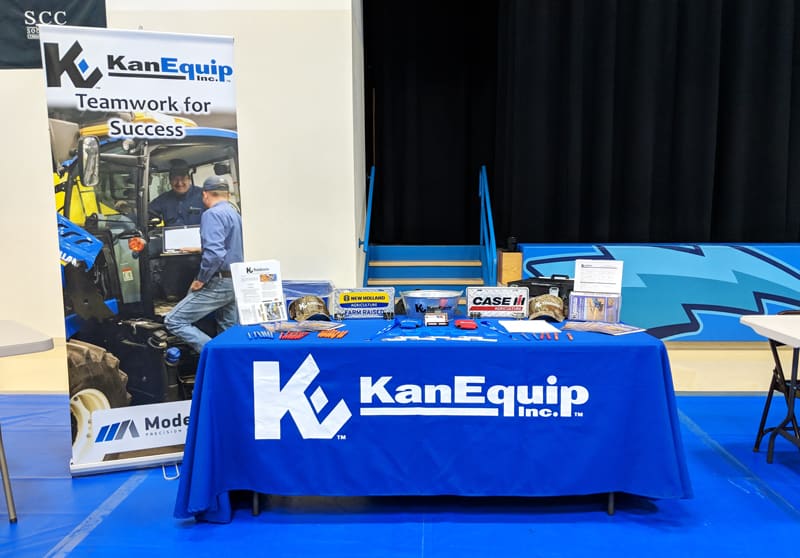
KanEquip's Richard Dugan, an ag technician recruiter and trainer, sets up promotional items and information about jobs at career fairs. (Photo courtesy of KanEquip)
The key is adapting instead of spurning perceived differences.
“They just think differently, and so you can’t manage the way we used to manage. You have to work around flex schedules. You need to understand that time off means more than the dollar on the paycheck,” Brozek says. “I think a lot of our managers struggle with that — they come in 5 minutes late, that’s disrespectful. They’re always asking for time off — OK, deal with it. We’ve got to learn how to deal with it, we can’t just say that it’s because it’s different, it’s wrong. This is how it is.”
Pay is always important. But creating the right culture goes a long way, too.
“It kind of is money, but also do you feel like you’re needed? Are you valued,” Dugan, the KanEquip recruiter, says. “Are you part of something big that helps the company move forward?”
KanEquip can get a pulse on its workforce when conducting “stay interviews” with current employees to ask why they’ve remained with the company. Most workers might be more familiar with exit interviews after an employee leaves.
“A lot of times, just check in. ‘Why do you stay at KanEquip?’ is one of the big questions we ask. What do you think of when you go to work? We’re always checking the temperature, testing the waters,” Dugan says. “Is there something that we can change?”
With 25 stores in 8 states, Stotz Equipment anticipates doubling in size in the next 5 years, so the company will be looking to fill positions in sales, parts and service in the near future. While Stotz attends high school and technical school career fairs to recruit for service technicians, representatives also go to college career events as they look for potential candidates for managerial roles.
Stotz also builds it bench with programs for aspiring leaders. Leadership 1.0 is a two-year program with two-day workshops every three months. Supervisors nominate employees to take the classes, which covers topics like managing people and finances.
Building on its success, Stotz started Leadership 2.0 a couple years ago. The goal of that program is for every manager to become a “coach,” Nielsen says.
These programs can help with retention by developing employee skills while also allowing the company to instill the values it wants to foster. “What is your story? Being able to kind of craft that so you really have a good pitch is absolutely important, and ultimately linking that story to a purpose,” Nielsen says.
The greatest success, he adds, is when employees are hired that fit the culture and personality of the company. “When you do that, regardless of technical skills, you’re going to find some good success, and you also want to find out what it is they’re looking for,” Nielsen adds. “When you hire that way, it also helps your retention.”
Related Content:
Filling the Skills Gap Requires Industry-Wide Effort
The Processes & Challenges of Hiring International Ag Technicians
Ag Equipment Technician Training Being Geared Toward High Schoolers
Vermeer Focuses on Workforce Development through STEM Education

